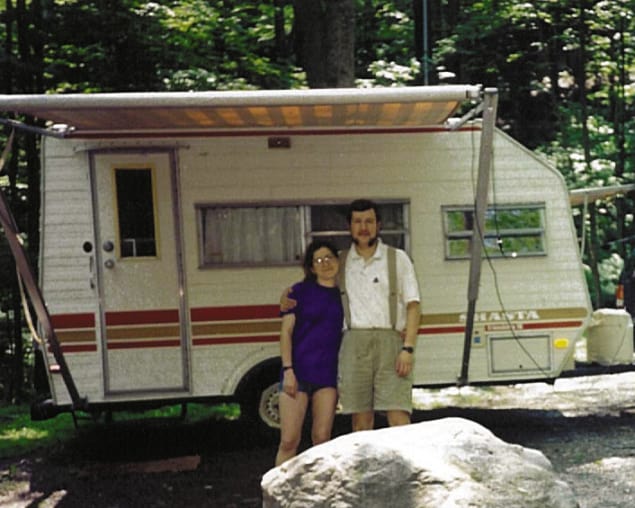For physicists who have fallen for the charms of one another, finding two permanent physics jobs in the same place is one of the toughest challenges they face. Valerie Jamieson asks couples how they cracked the two-body problem.

Gabriela González and Jorge Pullin of Louisiana State University in the US are living proof that Einstein was wrong when he said that gravitation was not responsible for people falling in love. They met when Pullin attended a meeting on gravitational physics in Cordoba, Argentina, where González was an undergraduate. Soon afterwards they both found positions at Syracuse University near New York – Pullin accepted a post-doc while González worked on her PhD.
After two years, however, the reality of short-term contracts kicked in and Pullin moved to take up another post-doc position in Utah, followed by a tenure-track position at Pennsylvania State University. Meanwhile, González accepted a job at Massachusetts Institute of Technology, a mammoth 10-hour drive from Penn State. They spent six years living apart. Undaunted, the couple found ways to meet as often as they could. “Since we work in closely related fields, we chose to go to conferences that we could attend together,” recalls González. And at weekends they used to meet in a caravan parked half way between Boston and Pennsylvania.
“Living apart was a considerable emotional – and financial – strain,” says González, “and we wouldn’t recommend it to anyone. In our case, it had a happy ending.” Eventually, they both found permanent positions at Louisiana State, where Pullin is a theorist and González works on the LIGO gravitational-wave interferometer. Both of them believe that the separation was worth it in the long run and helped them to increase their marketability.
Double trouble
Finding a permanent position in academia can be hard enough, but it is even tougher when your partner is in the same situation. Inevitably, compromises have to be made. Some physicists, like Pullin and González, choose to live apart temporarily for the sake of their careers, while others accept lower-grade positions to be close to their partners. Couples who have succeeded in combining a happy marriage with two physics careers have had to work hard at it, and have often relied on luck, e-mail and lateral thinking.

Commonly dubbed the “two-body problem”, finding two physics jobs in the same place is an issue that affects both men and women, and, importantly, physics employers. After all, what happens if the top candidate for a lectureship is married to a physicist who can’t find a job nearby? Chances are the candidate will reject the job offer or leave after a few years if their partner finds a better position elsewhere. “Ultimately your marriage is more important than your career,” says Stephen Blundell, a condensed-matter physicist at Oxford University. His astrophysicist wife, Katherine, currently holds a five-year Royal Society research fellowship, the latest in a succession of prestigious fellowships she has bagged to remain in Oxford.
Other couples who live hundreds of miles apart have found that their employers are sympathetic to their situation. Theresa Harrison of Birmingham University in the UK is married to Paul Harrison – a fellow particle physicist at Queen Mary College in London. “We’re lucky to have ‘visitor status’ at each other’s institution, which gives us access to a desk and a computer, for instance,” she says.
But some physicists draw the line at living in separate locations. “We decided very early on that we would not work in different cities,” recalls Stephen Blundell.
Follow you, follow me
Many couples choose to play the career equivalent of follow-my-leader, deciding that one of them should search for the best job available, while the other tags along. “I have spent my life going wherever my partner wanted to go and then somehow contriving to find a niche for myself,” says Althea Wilkinson, an astronomer at Jodrell Bank Observatory in the UK. Her husband, Peter Wilkinson, is associate director of the observatory and has never accepted that they would work in two different places. “I think it would have broken up the relationship, which is why I never attempted it,” she confides.
Theresa Harrison has also found that her career has been influenced by her husband’s choices. “I regard his career as more important than mine,” she confesses. “I’ve only considered positions in UK universities that work on the same particle-physics experiment as he does.”
But the follow-my-leader approach can lead to a great deal of soul-searching, as astrophysicists Moira Jardine and Andrew Cameron discovered in the early 1990s. At the time, they both held post-doctoral fellowships at Sussex University, with the promise of a lectureship for Cameron who was nearing the end of his contract. Then Jardine, whose career was some four years behind her husband’s, was offered a university lectureship a few hundred miles away in the north of England. After much deliberation, they decided that it was better to turn down the offer and stick together than risk finding a second job in the same place. It was the hardest decision they have had to make, admits Cameron.
“In the end the gamble paid off,” says his wife. “When three permanent positions were advertised simultaneously at St Andrews, we jumped at the chance to sell ourselves as a ‘package deal’ – a stellar-magnetic-activity team consisting of an observer and a theorist with 24-hour lines of communication.” They were offered two of the jobs.
The decision to accept should have been a “no brainer” but was complicated by the fact that Cameron had also been offered a more senior position elsewhere. “We both recognized that it would be almost impossible for me to get a permanent job there without it looking like nepotism,” recalls Jardine, who is now firmly ensconced at St Andrews with her husband and family.
Old-fashioned attitudes
Of course, the two-body problem is not unique to science or to academia. But it is a particular challenge for women physicists, according to a study carried out in 1998 by physicists Laurie McNeil from the University of North Carolina and Marc Sher at the College of William and Mary in the US. First because nearly 45% of married women physicists have husbands in the same field, compared with only 6% of men having physicist wives. And second because it is rare to find two physics jobs up for grabs at the same institution at the same time. Short-term contracts compound the problem. Often one partner can end up underemployed, or even unemployed. Indeed, the two-body problem has led to many people – especially women – leaving physics altogether.
Astronomer Donald Lynden Bell of Cambridge University, for instance, believes that his wife Ruth, now a professor in the atomistic-simulation group at Queen’s University in Belfast, remained in a job below her capabilities for 30 years until she accepted her chair in Belfast in 1995.
For the main part of their study, McNeil and Sher surveyed 620 couples where one partner was a physicist. They found that the choice of which partner plays which role can be influenced by professional seniority and research field. “Solid-state physicists tend to get permanent jobs earlier than particle physicists do,” argues Christine Davies, a particle theorist at Glasgow University in the UK.
She went to Glasgow specifically because her husband John was offered a permanent job there. “I only had a temporary lectureship to start with, and then I got an advanced fellowship with the Particle Physics and Astronomy Research Council,” she says. “When it looked as if I would not get a permanent job we decided to leave, and started looking elsewhere. But then the situation in Glasgow suddenly changed and I was offered a position, so we stayed.”
Others are not so lucky. According to McNeil and Sher, problems can arise when the number of job applicants outstrips the number of vacancies. With so many qualified hopefuls, some institutions believe they have the right to restrict the position to candidates who do not have the complication of a physicist spouse. Although the law in many countries prohibits interviewers from asking candidates about their marital status, many go ahead and ask anyway according to Sher, who was shocked by the repeated disregard for the law in interviews.
He reveals that one candidate was told that she would not be considered for the job if her husband did not have a job nearby. “Many remarks sound like the sort of thing one would have heard 25 years ago,” says McNeil. “I would have thought that people who continue to hold such views would have begun to keep them to themselves.”
But as Theresa Harrison points out, in a tight-knit community like particle physics, potential employers often know about your domestic situation before they have met you.
Helping hand
Although there is no magic answer to the two-body problem, many physicists have found that institutions do try and offer help – of sorts. Back in the 1960s when theorist Helen Quinn finished her PhD at the Stanford Linear Accelerator Center in California, she and her husband, Dan, applied for various post-doc positions. “We got two offers from the Daresbury Laboratory in the UK,” she recalls, “and a telegram from the DESY lab in Germany that said our applications had been accepted and a letter would follow.” On that basis they turned down the Daresbury jobs. “When the letter finally arrived, it was only addressed to my husband and offered him a position and a salary,” adds Quinn.
Although the lab agreed to increase her husband’s salary if she worked there too, the additional money was less than half his salary. The Quinns accepted anyway because, as she says, “we no longer had any other choices”. There was some logic to the offer, she concedes. At that time DESY paid American researchers more than they paid Germans; the total offer was the equivalent of two German salaries.
Some universities even offer to help partners find a job on or off campus. “One of our previous employers had a ‘dual-career office’,” says Pullin at Louisiana State. “We wrote to them, but they never got back to us.”
Christine Davies has a happier tale to tell. When she and her husband went to Cornell University in the US, she was the only one with a post-doc position but Cornell found some money to support her husband. Stephen and Katherine Blundell also found a potential employer who was sympathetic to the fact that they would only move together. “It only would have worked because the university was interested in us both as individuals,” stresses Katherine.
Lessons in love
So what are the lessons for young physics couples who have yet to find permanent jobs? Certainly each partner should be wholeheartedly committed to the career of the other. “You must both be prepared to compromise if you want to stay together,” warns Christine Davies. “Also be realistic about the chances of either of you getting a permanent job – ask senior colleagues for advice.”
Many couples have found that fellowships are the answer as they can often be taken from one institution to another. “They also carry prestige and add enormously to your chances of getting a permanent job,” adds Davies. Colleges at Oxford and Cambridge University can also be accommodating, offering fellowships that are distinct from university positions.
“Don’t give up and be prepared to negotiate your terms,” says Theresa Harrison. “There is a shortage of good physicists and employers are often prepared to be flexible for the right candidate.”
In spite of the stresses and strains of a two-physicist relationship, there are plenty of upsides too. Having a partner who understands that physics research can sometimes be all-consuming is probably the biggest bonus. After all, creative insight and breakthroughs are not confined the nine-to-five working day. Neither are the sudden pressures that teaching and exam marking can bring.
Being able to go to conferences with your other half is another plus point: you get to travel the world together and make friends in new countries, although it can be hard to avoid talking shop all the time. The flexibility of academic life also means you can often go on sabbatical together. And you always have someone at hand to proof read your papers and point out the jargon.
“We even occasionally discuss physics,” says Christine Davies, “but thank goodness we don’t work together!”
Many-body problem
If you think the two-body problem is tricky, then the real challenge comes when you add children to the equation. “It’s a problem that many women find they cannot recover from,” says Althea Wilkinson at Jodrell Bank, who has had first-hand experience of the problem. “I had been a temporary physics lecturer at Manchester University for nine years when I was made redundant for not doing enough research while my children were young.” She found help in the form of a Daphne Jackson fellowship, a scheme that allows scientists and engineers to return to research in the UK following a career break due to family commitments. Wilkinson firmly believes that there should be more schemes like it.
Happily Andrew Cameron and Moira Jardine at St Andrews find that working at the same institution offers greater flexibility when the inevitable family emergencies arise. And they should know. Two years ago Cameron stepped in to finish his wife’s lecture courses when their third baby arrived three weeks earlier than planned!



